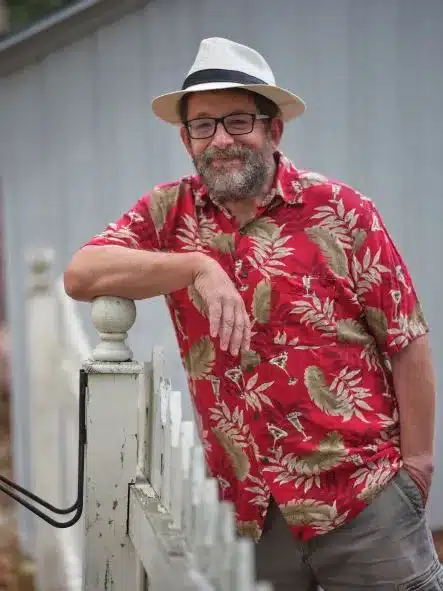We’re welcoming Historical Mystery Author RJ Koreto to the MRC today! We’re longtime fans of his writing and after reading his latest book, The Turnbull Murders, we asked if he’d let us interview him and he said YES! Epp!
About RJ Koreto

Over the years, R.J. Koreto has been a magazine writer, website manager, textbook editor, novelist and merchant seaman.
He was born and raised in New York City, attended the Fieldston School and graduated from Vassar College. He has wanted to be a writer since reading The Naked and the Dead.
In addition to his novels, he has published short stories in Ellery Queen’s Mystery Magazine, Alfred Hitchcock’s Mystery Magazine, the 2020 Bouchercon Anthology and Paranoia Blues: Crime Fiction Inspired by the Songs of Paul Simon.
With his wife and daughters, he divides his time between Rockland County, N.Y., and Martha’s Vineyard, Mass.
Find him at https://rjkoreto.com/
The Interrogation (or Interview) with RJ Koreto
The Turnbull Estate, with its rich history and mysterious past, serves as a captivating backdrop for the story. How did you go about creating the atmosphere and setting for the novel to make it not just a location but a character in itself?

I had a lot to draw on here! Two of my favorite books contain fascinating homes: Rebecca and Wuthering Heights. And don’t forget Tara. Then there’s my own home in Rockland County, northwest of New York: my wife and I live in a house built in 1850. Our neighbor said his house and ours are twins, built by brothers who farmed the land before the Civil War. When we had our kitchen redone, our contractor was astonished, finding our internal structure was like something out of a history book. It made it all very real to me.
The interplay between the characters, such as Wren, Nicky, Saffron, and Hadley, adds depth to the narrative. Can you elaborate on how you crafted the relationships and dynamics among the characters, especially considering their varying roles in the restoration project and the investigation?
Oh, that’s the key part, isn’t it? Thinking about how people relate to each other! That’s both the hardest part and the most fun. Wren and Hadley fall for each other in the first book in the series, The Greenleaf Murders. They are different in so many ways, connecting like puzzle pieces, filling holes in each other’s life. And my characters all come with a “past.” Not to give anything away, but the Turnbull mansion forces movie star Nicky, his “companion” Saffron, and his lovesick assistant Cal to confront their own pasts, with results both liberating—and tragic. When we meet someone for the first time, we don’t usually think about the journey that made them who they are, and yet, that is essential in fiction. And in life. This is hardly new to me! Look at the greatest novel of the past, The Great Gatsby: “Whenever you feel like criticizing anyone, he told me, just remember that all the people in this world haven’t had the advantages that you’ve had.”
The connection between the house and the murders, both past and present, is a central theme. How did you navigate the storytelling to convey the idea that the house itself plays a role in the unfolding mysteries?
That’s the general theme of the Wren Fontaine Historic Homes series—our relationship with the homes we live in. Gilded Age mansions (as found in the first Wren Fontaine book, The Greenleaf Murders) were de facto palaces where fantastically wealthy merchant princes could rule—but what does that mean today, when the formerly ruling family is just a forgotten footnote in city history? And in the Turnbull Murders, we go back to an earlier age, to the “federal style” pioneered by Thomas Jefferson. This style was based on ancient Greece and Rome, to a Republican ideal the new country wanted to emulate. The result was an extraordinary sense of harmony. But could the original family adapt to this harmony 200 years ago? Can it affect, for better or worse, the owners today?
In Wren’s next mystery, available later this year, she works on a 1950s modernist masterpiece, the strangely compelling Cadieux House. Wren’s father thinks it’s one of the finest homes ever built, but Wren finds its odd curves and angles less than welcoming. It was born of the chaos of World War II: What does the fantastical design say about the people who lived there, the dark secrets they hid from the world, and the unsolved murder that occurred in its living room 75 years ago? What does it say about the people who own it today—and the murders that keep happening?
What was the first story or piece of writing you remember creating? How has your writing evolved since then?
I don’t know if they’re read anymore, but I was passionate about C.S. Forester’s Hornblower’s books, adventures about a British naval officer during the Napoleonic Wars. So I started writing adventure stories myself as a boy. I remember writing a piece about a secret agent in Elizabethan England, after seeing the Queen Elizabeth series with Glenda Jackson.
Are there any specific authors or books that influenced you early in your writing journey?
My earliest mystery influence was the Hardy Boys series and I graduated to Sherlock Holmes. The writer who made the biggest impression on me was John le Carre. No other writer I know so deftly navigates the complex moral decisions and compromises people have to make.
Are you a planner or a “pantser” (writing by the seat of your pants)? How do you approach structuring your stories?
Great one! My background is in journalism, and working on tight deadlines meant I had to plan carefully as I wrote. I generally approach fiction the same way, with careful planning. But sometimes I have to be a pantser: In my first Wren Fontaine book, I planned for her to have a romance with her client’s nephew. But when I got them together—it didn’t feel right to me. I shrugged, and kept writing, hoping to work it out later. And then Wren met her client’s niece—and sparks flew! I hadn’t realized Wren was a lesbian! As Stephen King says, “When the work is the best work, it’s more like being a secretary than it is a creative person, you just sort of take the stuff down.”
Can you share a funny or heartwarming anecdote related to your writing journey?
My first book was Death on the Sapphire, a mystery featuring Lady Frances Ffolkes, a suffragette and amateur sleuth in Edwardian London. A reader wrote to me saying, “I wish Lady Frances was real so she could be my friend.” It doesn’t get any better than that! But I also had a reverse problem with an earlier novel, which remains unpublished. A publisher sent it back saying it was well-written, but they were taking a pass because he found every single character “repellent.” I liked my characters—even the bad guys! So I began to worry—not that I was a bad writer, but that I might be a sociopath.
How do you envision the future of literature and storytelling, and how do you see yourself contributing to it?
People always worry about the end of fiction, but we were telling stories probably before we could write. You can draw a line from Homer to Salman Rushdie. Read Chaucer’s “The Miller’s Tale.” Once you get over the Middle English spelling, what is striking is not how much fiction has changed—but how little! I mean that in a very optimistic way: our love of stories, and finding inventive ways to tell them, never ends.
Are there any exciting projects or new directions you’re planning to explore in your upcoming works?
I was very impressed by Norman Mailer’s “Harlot’s Ghost,” which uses the CIA as a lens to look at post-war America. I wanted to do something similar. So I wrote an as-yet-unpublished mystery called “The Constable’s Lady.” Young Constable Heath in rural England in the 1880s comes across the Earl’s savagely murdered daughter Patience. The Earl’s power and money quickly shut down the investigation, but Heath never forgets Patience. He rises through the ranks at Scotland Yard and over the years he travels to colonial India and Germany in the final days of World War I to get justice for Patience. After 35 years, Heath succeeds, as the Earl’s family—and Heath himself—struggle to come to terms with a much-changed country.
Thanks for letting us interview you Author RJ Koreto! Always a pleasure getting to talk to you.
Check out RJ Koreto’s A Historic Homes Mystery Series
*Affiliate links are used in this article. The Mystery Review Crew is an Amazon Affiliate and, as such, earns from qualifying purchases. See our privacy policy and disclosures for more information.
The Greenleaf Murders
Young architect Wren Fontaine lands her dream job: restoring Greenleaf House, New York’s finest Gilded-Age mansion, to its glory days. But old homes have old secrets: Stephen Greenleaf-heir to what’s left of his family’s legacy-refuses to reveal what his plans are once the renovation is completed. And still living in a corner of the home is Stephen’s 90-year-old Aunt Agnes who’s lost in the past, brooding over a long-forgotten scandal while watching Wren with mistrust.
Wren’s job becomes more complex when a shady developer who was trying to acquire Greenleaf House is found murdered. And after breaking into a sealed attic, Wren finds a skeleton stuffed in a trunk. She soon realizes the two deaths, a century apart, are strangely related. Meanwhile, a distraction of a different kind appears in the form of her client’s niece, the beautiful and seductive Hadley Vanderwerf. As Wren gingerly approaches a romance, she finds that Hadley has her own secrets.
Then a third murder occurs, and the introverted architect is forced to think about people, and about how ill-fated love affairs and obsessions continue to haunt the Greenleafs. In the end, Wren risks her own life to uncover a pair of murderers, separated by a century but connected by motive. She reveals an odd twist in the family tree that forever changes the lives of the Greenleafs, the people who served them, the mansion they all called home-and even Wren herself.
The Turnbull Murders
Movie star Nicky Tallon selects architect Wren Fontaine to renovate Turnbull House, where he’ll be filming his next movie. Even to Wren, used to old homes, this one is special: a 200-year-old federal-style home on a private island in New York harbor, designed by the most celebrated architect of the day. But Turnbull House hides many secrets, such as the disappearance of the sea captain who built it. That’s just a historical curiosity, until a studio executive no one likes is killed.
Wren just wants to keep her worksite safe, but then another murder occurs, and she starts noting eerie connections between the mysteries surrounding the Turnbull family and Nicky and his entourage. The handsome star seems to have two girlfriends, a childlike folk singer and a cynical fashion model. Meanwhile, renowned actress Veronica Selwyn renews a friendship with Wren’s father, which Wren finds more disturbing than she wants to admit. She concludes it’s time she and her girlfriend Hadley take the next step and find a place together, an exciting but stressful change.
As the attacks continue, Wren realizes she will have to solve the mysteries surrounding Captain Turnbull and Nicky Tallon. Turnbull House speaks of order and harmony, and Wren must dig deep to see how the house has affected its owners, old and new. Fortunately for her, the eminently practical Hadley is by her side, pepper spray at the ready-because a frighteningly clever killer is about to find that Wren is getting too close to the horrific truth.







